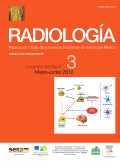
RADIOLOGIA
Scope & Guideline
Advancing the frontiers of imaging and nuclear medicine.
Introduction
Aims and Scopes
- Clinical Radiology and Imaging Techniques:
The journal covers a broad spectrum of clinical radiology topics, including the latest imaging techniques such as MRI, CT, ultrasound, and interventional radiology, aimed at improving diagnostic accuracy and patient outcomes. - Education and Training in Radiology:
A significant focus is placed on the education and training of radiologists, including methodologies for teaching imaging skills, curriculum development, and the integration of new technologies such as artificial intelligence into educational programs. - Research and Development in Radiological Practices:
The journal encourages research that contributes to the development of innovative practices in radiology, including studies on diagnostic accuracy, patient safety, and procedural advancements. - Interventional Radiology:
A dedicated section for interventional radiology highlights advancements in minimally invasive procedures, showcasing case reports, techniques, and outcomes that demonstrate the evolving role of radiologists in patient treatment. - Legal and Ethical Issues in Radiology:
The journal addresses the legal and ethical dimensions of radiological practice, particularly concerning emerging technologies like artificial intelligence, and the implications for clinical practice and patient care.
Trending and Emerging
- Artificial Intelligence and Machine Learning in Radiology:
There is a growing trend towards the integration of artificial intelligence and machine learning into radiological practices, with numerous studies exploring their applications in diagnosis, predictive analytics, and workflow optimization. - Sustainability in Radiology:
Emerging interest in sustainable practices within radiology, including 'green radiology' initiatives, reflects a commitment to reducing the environmental impact of imaging procedures and promoting more sustainable healthcare practices. - Patient Safety and Quality Improvement:
An increasing focus on patient safety measures, including risk management strategies and the implementation of protocols to enhance the quality of radiological services, showcases a shift towards prioritizing patient welfare. - Telemedicine and Remote Imaging:
The rise of telemedicine has led to an increase in publications focusing on remote imaging and teleradiology, emphasizing the need for accessible radiological services in various clinical settings. - Interdisciplinary Collaboration:
A trend towards interdisciplinary collaboration is evident, with studies highlighting the role of radiologists in multidisciplinary teams, particularly in complex cases and integrated care approaches.
Declining or Waning
- Traditional Radiological Techniques:
There has been a noticeable decline in publications focusing solely on traditional imaging techniques, such as plain X-rays, as the field moves towards more advanced modalities and techniques that offer greater diagnostic capabilities. - Non-interventional Imaging Studies:
The focus on purely observational studies without interventional components has decreased, likely due to a growing emphasis on practical applications and outcomes in clinical settings. - General Overviews and Review Articles:
The frequency of broad review articles covering established topics in radiology has waned, as the journal shifts towards more specific, research-driven articles that provide deeper insights into niche areas.
Similar Journals
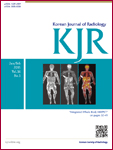
KOREAN JOURNAL OF RADIOLOGY
Transforming Radiological Practices Through ResearchKorean Journal of Radiology (ISSN: 1229-6929, E-ISSN: 2005-8330), published by the Korean Society of Radiology, stands as a leading international platform for the dissemination of high-quality research and advancements in the fields of radiology, nuclear medicine, and imaging. With a remarkable impact factor and ranked in the Q1 quadrant in its category, this journal showcases cutting-edge studies, clinical investigations, and comprehensive reviews that significantly contribute to the understanding and practice of medical imaging. Researchers, clinicians, and students alike will find the journal an invaluable resource, featuring innovative methodologies, case studies, and essential updates in imaging technology. Since its inception in 2000 and continuing through 2024, the Korean Journal of Radiology remains dedicated to promoting excellence and fostering collaborative research within the global radiology community, underscoring the importance of imaging in modern medicine.
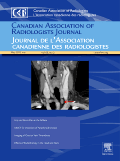
CANADIAN ASSOCIATION OF RADIOLOGISTS JOURNAL-JOURNAL DE L ASSOCIATION CANADIENNE DES RADIOLOGISTES
Elevating Knowledge: Your Gateway to Radiological ExcellenceCanadian Association of Radiologists Journal - Journal de l'Association Canadienne des Radiologistes, published by SAGE Publications Inc, stands as a vital resource in the realms of Radiology and Medicine. With an ISSN of 0846-5371 and an E-ISSN of 1488-2361, this esteemed journal offers insightful research articles and reviews that contribute to the advancement and practice of radiology, benefiting both seasoned professionals and emerging scholars. Holding a commendable Q2 ranking in both the fields of Medicine (miscellaneous) and Radiology, Nuclear Medicine and Imaging, the journal is recognized for its impactful publications, positioning its content within the top 40% of global research outputs. Since its inception in 1973 and continuing through to 2024, it has consistently provided a platform for cutting-edge research and clinical innovations, facilitating knowledge transfer among practitioners and educators. The journal’s significant influence is evidenced by its Scopus rank of #67 out of 333 in its category, placing it in the 80th percentile of academic excellence. Although it does not offer open access, its contributions are critical for advancing the field, making it essential reading for all those invested in the evolution of radiological sciences.

Radiologia Medica
Innovative Research Bridging Disciplines in Radiology.Radiologia Medica, published by Springer-Verlag Italia SRL, is a premier Italian journal dedicated to the field of radiology, nuclear medicine, and imaging. With a rich history dating back to 1947, this journal has consistently provided cutting-edge research and findings, contributing significantly to advancements in medical imaging techniques and practices. As evidenced by its impressive Q1 rankings in both Medicine (Miscellaneous) and Radiology, Nuclear Medicine and Imaging, Radiologia Medica holds a prestigious position within the top tier of medical journals, ranked #11 out of 333 in its category and residing in the 96th percentile according to Scopus metrics. Although it is not currently offered as an Open Access journal, its robust subscription model supports extensive research dissemination. Researchers, professionals, and students alike will find invaluable insights and knowledge critical for advancing their understanding and practice within this dynamic field. Situated in Milan, Italy, Radiologia Medica continues to be an influential platform for the exchange of high-quality research, bridging various disciplines and promoting excellence in radiological science.

EUROPEAN JOURNAL OF RADIOLOGY
Transforming Patient Care Through Radiological ResearchThe European Journal of Radiology, published by Elsevier Ireland Ltd, is a premier peer-reviewed journal in the fields of radiology, nuclear medicine, and imaging. Established in 1981, it has carved a significant niche within the academic community, showcasing innovative research that enhances medical imaging practices and improves patient care. With an impressive ranking in the Q1 category for both Medicine (miscellaneous) and Radiology, Nuclear Medicine, and Imaging in 2023, the journal is recognized globally for its commitment to advancing scientific knowledge and improving imaging methodologies. The journal's Scopus ranking of #60/333, placing it in the 82nd percentile, underlines its reputation for high-quality research and scholarly contributions. While traditionally a subscription-based journal, it continually evolves to meet the demands of the academic landscape, aiming to bridge the gap between research and clinical practice. Researchers, healthcare professionals, and students alike can benefit from exploring its extensive archives and current publications, which are curated to foster education and innovation in the medical imaging domain.

Egyptian Journal of Radiology and Nuclear Medicine
Pioneering Research for a Healthier TomorrowThe Egyptian Journal of Radiology and Nuclear Medicine, published by Springer, is a premier open access journal that has provided valuable insights and advancements in the fields of radiology and nuclear medicine since its initiation in 2010. With an E-ISSN of 2090-4762, this journal is dedicated to bridging the gap between research and clinical practice, allowing for the dissemination of high-quality research to a global audience. Situated in Germany, it enjoys a robust reputation in the academic community, evidenced by its categorization in the Q3 quartile for 2023, as well as its Scopus ranking, where it holds a position of #225 out of 333 in the domain of Radiology, Nuclear Medicine and Imaging, placing it in the 32nd percentile. The journal's open access model ensures that researchers, professionals, and students can freely access innovative studies, reviews, and case reports that discuss the latest methodologies, technological advancements, and clinical outcomes in radiology and nuclear medicine. As it looks toward its converged years spanning from 2010 to 2024, the Egyptian Journal of Radiology and Nuclear Medicine continues to be an essential resource for advancing knowledge and fostering ongoing collaboration in these critical fields.
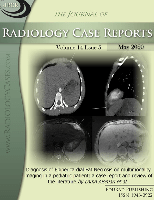
Journal of Radiology Case Reports
Exploring the Frontiers of Radiology Through Groundbreaking Case ReportsThe Journal of Radiology Case Reports is a pioneering open-access journal dedicated to the publication of original case reports in the field of radiology, providing a crucial platform for the dissemination of valuable clinical insights and advancements in diagnostic imaging. Published by EDURAD since 2008, this journal aims to bridge the gap between clinical practice and ongoing research by showcasing unique cases that can enhance diagnostic accuracy and patient care. With an ISSN of 1943-0922, the journal is committed to excellence, evidenced by its current ranking in the Scopus database, where it stands at position #253 among 333 titles in the field, corresponding to a 24th percentile. The journal is indexed in notable databases and features an HIndex reflective of its ongoing contribution to medical literature. Researchers, professionals, and students can access insightful articles covering diverse case scenarios, thus enriching their knowledge of medical laboratory technology and enhancing their expertise in radiology, nuclear medicine, and imaging. The journal not only provides a wide reach through its open access model but also encourages collaborative research efforts, fostering the rapid circulation of case-based knowledge essential to the evolving landscape of radiological science.

Diagnostic and Interventional Radiology
Unlocking the Future of Radiology Through Open AccessDiagnostic and Interventional Radiology, published by the Turkish Society of Radiology, is a renowned open-access journal dedicated to advancing the fields of radiology, nuclear medicine, and imaging. With its transition to open access in 2022, the journal aims to foster knowledge dissemination and accessibility for researchers, healthcare professionals, and students alike. This esteemed publication, indexed in Scopus, features a robust editorial board and peer-reviewed articles that contribute significantly to the body of work in cardiology, radiology, and related disciplines. The journal currently holds a significant position, reflected in its Category Quartiles ranking—Q2 in Radiology, Nuclear Medicine, and Imaging, and Q3 in Cardiology and Cardiovascular Medicine, highlighting its relevance and impact in these critical medical fields. Research published in this journal is vital for evolving diagnostic and interventional techniques, clearly situating it as a key resource for those seeking to stay at the forefront of radiological science.
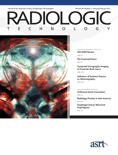
Radiologic Technology
Pioneering Research in Imaging and Nuclear MedicineRadiologic Technology, published by the American Society of Radiologic Technologists, serves as a pillar in the fields of radiology, nuclear medicine, and imaging, providing critical insights and advancements that shape the practice and profession. With an ISSN of 0033-8397 and E-ISSN 1943-5657, this esteemed journal has been contributing to the scholarly literature since 1963 and continues its commitment to quality research well into 2024. Although it is not an open-access journal, Radiologic Technology is recognized for its robust contributions, holding a Q3 quartile ranking in both "Radiological and Ultrasound Technology" and "Radiology, Nuclear Medicine, and Imaging," according to the latest 2023 category quartiles. Its Scopus rankings highlight its standing within the field, offering thought-provoking articles that encourage further exploration and innovation. As the landscape of medical imaging evolves, this journal remains a crucial resource for researchers, practitioners, and students aiming to enhance their understanding of radiologic technologies and their applications in modern healthcare.

SEMINARS IN ROENTGENOLOGY
Advancing the Frontiers of Imaging ScienceSEMINARS IN ROENTGENOLOGY is a revered journal dedicated to the dynamic fields of Radiology, Nuclear Medicine, and Imaging, published by W B SAUNDERS CO-ELSEVIER INC. With a legacy spanning from 1966 to 2024, this journal provides a platform for comprehensive review articles that foster scholarly discussion and advancement in diagnostic imaging techniques and methodologies. Although currently not an open access publication, SEMINARS IN ROENTGENOLOGY holds significant relevance within its field, reflected by its inclusion in the Q4 category in the latest 2023 Journal Rankings and its position in the 20th percentile among its peers. This journal appeals widely to researchers, professionals, and students aiming to enhance their knowledge and contribute to the evolving landscape of radiologic science. Notable for its informative content and expert insights, SEMINARS IN ROENTGENOLOGY continues to serve as an essential resource for those committed to advancing clinical practice and research in radiology.

Japanese Journal of Radiology
Pioneering Insights in Radiological PracticesThe Japanese Journal of Radiology, published by SPRINGER, serves as a premier platform for disseminating cutting-edge research and clinical advancements in the fields of radiology, nuclear medicine, and imaging. With an ISSN of 1867-1071 and E-ISSN 1867-108X, this journal has established itself as a vital resource for practitioners, researchers, and students alike. Renowned for its high-quality peer-reviewed articles, it currently enjoys a respectable impact factor within the Q2 category of Scopus rankings, placing it in the 69th percentile among 333 journals in its field. The journal has seen consistent convergence of research from 2009 to 2024, further underscoring its commitment to advancing the understanding of radiological practices. Importantly, the journal offers Open Access options to facilitate widespread dissemination of knowledge, ensuring that vital research reaches its audience without barriers. Addressed in Japan, the Japanese Journal of Radiology plays a critical role in enhancing the global discourse on medical imaging, making it an essential resource for anyone engaged in this dynamic field.